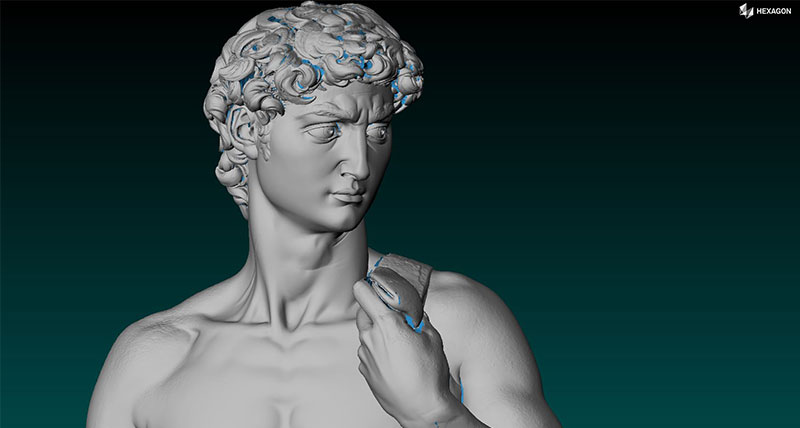The art piece takes its place in the Theatre of Memory at Italian Pavilion at Expo Dubai.
A 3D printed replica of Michelangelo’s famous David sculpture, re-produced with the use of scanning technology by Hexagon, was unveiled this week during a ceremony at the Italy Pavilion at Expo 2020 Dubai.
The event was attended by the Italian Minister of Foreign Affairs and International Cooperation, Luigi Di Maio, the United Arab Emirates’ Minister of State for Tolerance, Ahayan Mabarak Al Nahayan, the Minister of State for International Cooperation and Managing Director for Expo 2020 Dubai Reem Al Hashimy, and the Minister for Culture and Youth, Noura Al Kaabi. The so-called David Twin will be the centrepiece of the Pavilion’s Theatre of Memory.
The project to create the replica posed numerous challenges, not least due to the scale of the original, which stands at over seven metres tall and weighs more than five tons. Scanning this iconic sculpture took two people 10 days to complete. Two Hexagon technologies, an AICON StereoScan neo structured light scanner and a Leica Absolute Tracker with handheld scanner, were used to ensure optimum accuracy while managing the scale of the challenge. The mix of these two technologies was critical to achieve the best result; the laser tracker, which is typically used to measure precision aerospace components, is able to give high accuracy across large areas and the structured light scanner is able to achieve even higher resolution when focused on small areas. This instrument was used for the particularly detailed elements of the sculpture such as the face and hands. By combining these technologies, the team was able to achieve the optimum compromise of scale and resolution.
Following David’s appearance at the Expo, the digital twin created by the scanning process will be analysed to derive additional learnings. The extraordinary detail of the data reveals, for example, the effects of acid rain, dust, and even traces of the different tools used to create it. This information can be used by experts and restorers to preserve the David, and other iconic art pieces, by anticipating and preventing degradation.
It’s also recognised that there may be opportunities for future, more accurate scans of the David and other iconic art pieces. This latest project follows a similar one completed by Stanford University in 1999, which took one month and 22 people to achieve a lower resolution scan. As technology advances it’s hoped that an even higher level of detail can be achieved.
“Scanning the David presented a number of challenges,” says Cesare Cassani, Automation Technologies & Portable Systems Manager, Hexagon’s Manufacturing Intelligence division. “Not only was the scale enormous, but the time constraints were also tight, and we had to overcome a number of obstacles as we went along. Specific parts such as the inside of the hands, and underneath the bent arm, for example, proved particularly challenging, as well as capturing all the dents and imperfections that the David has incurred over the years.”
“The opportunity of being part of the team who has worked at this project is not only a high recognition of Hexagon’s technology and expertise in digital transformation, it is also for us a matter of pride in contributing to the scientific research and to the disclosure of culture and art throughout the world” says Levio Valetti, Marketing and Communications Manager, Hexagon Commercial Operations Italy.
The re-production of Michelangelo’s David is a project jointly promoted by the Italian General Commissioner’s Office for Expo 2020 Dubai, the Galleria dell’Accademia Museum of Florence and the Ministry of Culture in partnership with the Department of Civil and Environmental Engineering at the University of Florence.
For more information please visit: https://italyexpo2020.it/en/memory-and-future-michelangelos-david-at-expo-2020-dubai/
Press Contacts:
Levio Valetti, Marketing and Communications Manager (Italy)
Divisione Manufacturing Intelligence, Hexagon
E-mail: levio.valetti@hexagon.com
Robin Wolstenholme, Global Media Relations and Analyst Relations Manager
Manufacturing Intelligence division, Hexagon
Tel: +44(0)207 0686562
Email: robin.wolstenholme@hexagon.com or media.mi@hexagon.com
About Hexagon
Hexagon is a global leader in sensor, software and autonomous solutions. We are putting data to work to boost efficiency, productivity, and quality across industrial, manufacturing, infrastructure, safety, and mobility applications.
Our technologies are shaping urban and production ecosystems to become increasingly connected and autonomous – ensuring a scalable, sustainable future.
Hexagon’s Manufacturing Intelligence division provides solutions that utilise data from design and engineering, production and metrology to make manufacturing smarter.
Hexagon (Nasdaq Stockholm: HEXA B) has approximately 21,000 employees in 50 countries and net sales of approximately 3.8bn EUR. Learn more at hexagon.com and follow us @HexagonAB.









